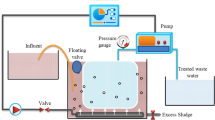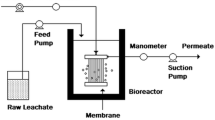Abstract
This study proposes a model-based evaluation of the effect of different operating conditions with and without pre-denitrification treatment and applying three different solids retention times on the fouling mechanisms involved in membrane bioreactors (MBRs). A total of 11 fouling models obtained from literature were used to fit the transmembrane pressure variations measured in a pilot-scale MBR treating real wastewater for more than 1 year. The results showed that all the models represent reasonable descriptions of the fouling processes in the MBR tested. The model-based analysis confirmed that membrane fouling started by pore blocking (complete blocking model) and by a reduction of the pore diameter (standard blocking) while cake filtration became the dominant fouling mechanism over long-term operation. However, the different fouling mechanisms occurred almost simultaneously making it rather difficult to identify each one. The membrane “history” (i.e. age, lifespan, etc.) seems the most important factor affecting the fouling mechanism more than the applied operating conditions. Nonlinear regression of the most complex models (combined models) evaluated in this study sometimes demonstrated unreliable parameter estimates suggesting that the four basic fouling models (complete, standard, intermediate blocking and cake filtration) contain enough details to represent a reasonable description of the main fouling processes occurring in MBRs.




Similar content being viewed by others
Abbreviations
- n :
-
Number of experimental data
- p :
-
Number of parameters to estimate
- J :
-
Flux (L m−2 h−1)
- J 0 :
-
Applied constant flux (L m−2 h−1)
- t :
-
Time
- TMP:
-
Transmembrane pressure (MPa). Note that the values reported for the TMP in this work always refer to the standardised value as described above (i.e. after correction for the temperature and as average value of a filtration phase; see “Data processing” section)
- TMP20 :
-
TMP normalised to the reference temperature of 20 °C
- TMPT :
-
TMP measured at the experimental temperature
- TMP i,measured :
-
Single TMP measure
- TMP i,estimated :
-
Single TMP estimated for each model fit
- k c :
-
Cake filtration constant (s m−2)
- k b :
-
Complete blocking constant (h−1)
- k i :
-
Intermediate blocking constant (m−1)
- k m :
-
Value of the m-esim parameter estimated
- \( {\overline{k}}_m \), k max, k min :
-
Normalised, maximum and minimum value of the m-esim parameter k m
- k s :
-
Standard blocking constant (m−1)
- k br :
-
Parameter incorporating membrane and suspension characteristics (m kg−1)
- SRT:
-
Solids retention time (day)
References
Bennett ND, Croke BFW, Guariso G et al (2013) Characterising performance of environmental models. Environ Model Softw 40:1–20
Bolton G, LaCasse D, Kuriyel R (2006) Combined model of membrane fouling: development and application to microfiltration and ultrafiltration membranes. J Membr Sci 277:75–84
Broeckmann A, Busch J, Wintgens T, Marquardt W (2006) Modeling of pore blocking and cake layer formation in membrane filtration for wastewater treatment. Desalination 189:97–109
Brookes A, Jefferson B, Guglielmi G, Judd SJ (2006) Sustainable flux fouling in a membrane bioreactor: impact of flux and MLSS. Sep Sci Technol 41:1279–1291
Charfi A, Ben Amar N, Harmand J (2012) Analysis of fouling mechanisms in anaerobic membrane bioreactors. Water Res 46(8):2637–2650
Cho BD, Fane AG (2002) Fouling transients in nominally sub-critical flux operation for a membrane bioreactor. J Membr Sci 209:391–403
Drews A (2010) Membrane fouling in membrane bioreactors: characterisation, contradictions, cause and cures. J Membr Sci 363:1–28
Drews A, Arellano-Garcia H, Schoneberger J et al (2009) Model-based recognition of fouling mechanisms in membrane bioreactors. Desalination 236:224–233
Duclos-Orsello C, Weiyi L, Chia-Chi H (2006) A three mechanism model to describe fouling of microfiltration membranes. J Membr Sci 280:856–866
Eui-Jong L, Young-Hoon K, Hyung-Soo K, Am J (2015) Influence of microbubble in physical cleaning of MF membrane process for wastewater reuse. Environ Sci Pollut Res 22(11):8451–8459
Ferraris M, Innella C, Spagni A (2009) Start-up of a pilot-scale membrane bioreactor to treat municipal wastewater. Desalination 237:190–213
Field RW, Wu D, Howell JA, Gupta BB (1995) Critical flux concept for microfiltration fouling. J Membr Sci 100:259–272
Guglielmi G, Chiarani D, Judd SJ, Andreottola G (2007) Flux criticality and sustainability in a hollow fibre submerged membrane bioreactor for municipal wastewater treatment. J Membr Sci 289:241–248
Hermia J (1982) Constant pressure blocking filtration laws—application to power-law non-Newtonian fluids. Trans I Chem E 60:183–187
Hlavacek M, Bouchet F (1993) Constant flowrate blocking laws and an example of their application to dead-end microfiltration of protein solutions. J Membr Sci 82(3):285–295
Iritani E (2013) A review on modelling of pore-blocking behaviours of membrane during pressurized membrane filtration. Dry Technol 31:146–162
Janus T, Paul P, Ulanicki B (2009) Modelling and simulation of short and long term membrane filtration experiments. Desalin Water Treat 8:37–47
Kim M, Sankararao B, Seungchul L, ChangKyoo Y (2013) Prediction and identification of membrane fouling mechanism in a membrane bioreactor using a combined mechanistic model. Ind Eng Chem Res 52(48):17198–17205
Laera G, Pollice A, Saturno D et al (2009) Influence of sludge retention time on biomass characteristics and clearing requirements in a membrane bioreactor for municipal wastewater treatment. Desalination 236:104–110
Li X, Wang X (2006) Modelling of membrane fouling in a submerged membrane bioreactor. J Membr Sci 278:151–161
Liu QF, Kim SH (2008) Evaluation of membrane fouling models based on bench scale experiments: a comparison between constant flowrate blocking laws and artificial neural network (ANNs) model. J Membr Sci 310 (1–2):393–401
Lousada-Ferreira M, van Lier JB, van der Graaf JHJM (2015) Impact of suspended solids concentration on sludge filterability in full-scale membrane bioreactors. J Membr Sci 476:68–75
Maere T, Villez K, Marsili-Libelli S et al (2012) Membrane bioreactor fouling behaviour assessment through principal component analysis and fuzzy clustering. Water Res 46:6132–6142
Mannina G, Di Bella G, Viviani G (2011) An integrated model for biological and physical process simulation in membrane bioreactors (MBR). J Membrane Sci 376(1–2):56–69
Meng F, Chae SR, Drews A et al (2009) Recent advances in membrane bioreactors (MBRs): membrane fouling and membrane material. Water Res 43:1489–1512
Monclús E, Ferrer G, Buttiglieri G et al (2011) Online monitoring of membrane fouling in submerged MBRs. Desalination 277:414–419
Ng A, Albert NL, Kim S (2007) A mini-review of modeling studies on membrane bioreactor (MBR) treatment for municipal wastewaters. Desalination 212:261–281
Ognier S, Wisniewski C, Grasmick A (2004) Membrane bioreactor fouling in sub-critical filtration conditions: a local critical flux concept. J Membr Sci 229(1–2):171–177
Pollice A, Giordano C, Laera G et al (2007) Physical characteristics of the sludge in a complete retention membrane bioreactor. Water Res 41:1832–1840
Sabia G, Ferraris M, Spagni A (2013) Effect of solid retention time on sludge filterability and activity: long-term experiment on a pilot-scale membrane bioreactor treating municipal wastewater. Chem Eng J 221:176–184
Sabia G, Ferraris M, Spagni A (2014) Online monitoring of MBR fouling by transmembrane pressure and permeability over a long-term experiment. Sep Purif Technol 122:297–305
Suarez JA, Veza JM (2000) Dead-end microfiltration as advanced treatment for wastewater. Desalination 127:47–58
Trussell RS, Adham S, Trussell RR (2005) Process limits of municipal wastewater treatment with the submerged membrane bioreactor. J Environ Eng 131:410–416
Vanrolleghem PA, Van Daele M, Dochain D (1995) Practical identifiability of a biokinetic model of activated sludge respiration. Water Res 29(11):2561–2570
Wang Z, Ma J, Tang CY et al (2014) Membrane cleaning in membrane bioreactors: a review. J Membr Sci 468:276–307
Wu J, He C, Jiang X, Zhang M (2011) Modeling of the submerged membrane bioreactor fouling by the combined pore constriction, pore blockage and cake formation mechanisms. Desalination 279:127–134
Xiao K, Wang X, Huang X et al (2011) Combined effect of membrane and foulant hydrophobicity and surface charge on adsorptive fouling during microfiltration. J Membr Sci 373(1–2):140–151
Xu K, Ren H, Ding L et al (2013) A review of membrane fouling in municipal secondary effluent reclamation. Environ Sci Pollut Res 20:771–777
Zarragoitia-Gonzalez A, Schetrite S, Alliet M et al (2008) Modelling of submerged membrane bioreactor: conceptual study about link between activated sludge biokinetics, aeration and fouling process. J Membr Sci 325:612–624
Acknowledgments
This study was conducted as part of a research and development project named SIRPAR “Integrated Strategies for Urban Wastewater Reclamation in the Apulia Region” financed by Regional authorities of Apulia. Gianpaolo Sabia has been partly supported by the Regional Technological Project funded by the Emilia-Romagna Region
Author information
Authors and Affiliations
Corresponding author
Additional information
Responsible editor: Bingcai Pan
Electronic supplementary material
Below is the link to the electronic supplementary material.
ESM 1
(PDF 8567 kb)
Rights and permissions
About this article
Cite this article
Sabia, G., Ferraris, M. & Spagni, A. Model-based analysis of the effect of different operating conditions on fouling mechanisms in a membrane bioreactor. Environ Sci Pollut Res 23, 1598–1609 (2016). https://doi.org/10.1007/s11356-015-5372-z
Received:
Accepted:
Published:
Issue Date:
DOI: https://doi.org/10.1007/s11356-015-5372-z




